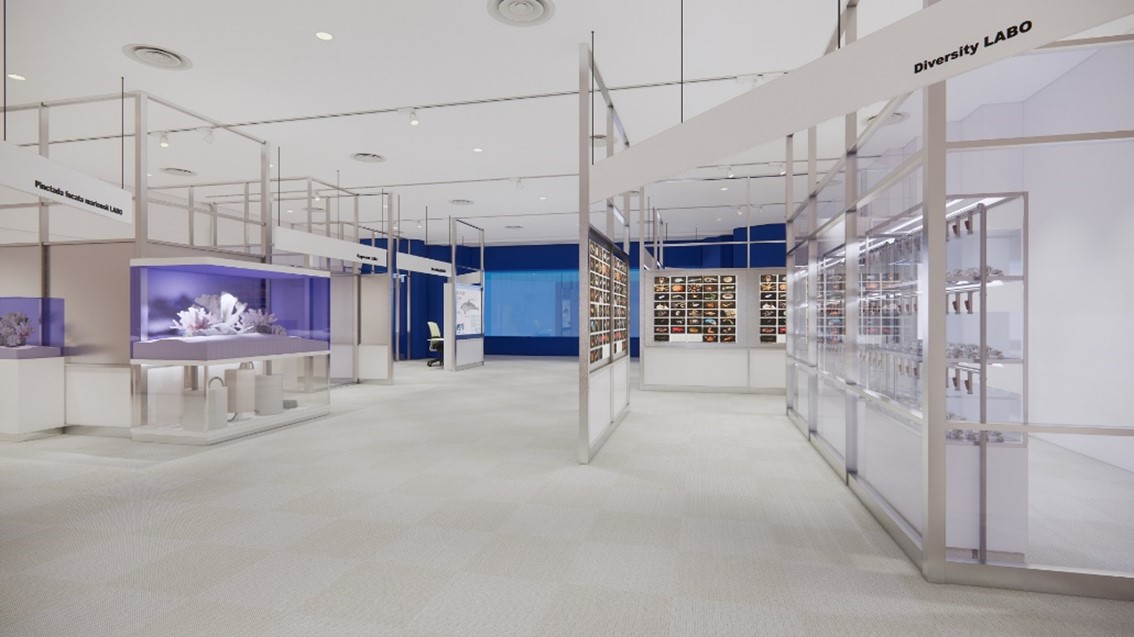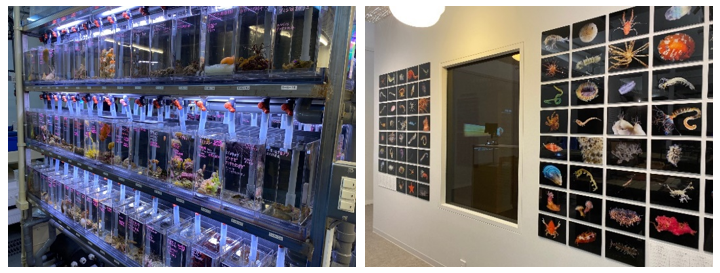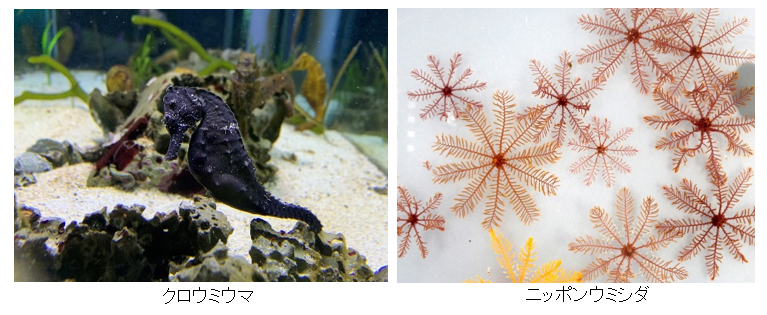DATE2022.06.21 #Press Releases
Institute for Marine Life Around Us [Opening Saturday, July 16, 2022].
Disclaimer: machine translated by DeepL which may contain errors.
-Birth of a base for learning about the SDGs in a fun way! -John
Yokohama Hakkeijima Sea Paradise
The University of Tokyo
On July 16, 2022 (Saturday), a new area, "Familiar Marine Life Institute," will open on the first floor of the Aqua Museum at Yokohama Hakkeijima Sea Paradise, focusing on "microscopic organisms living in the sea around us. The new area is an exhibition space where visitors can see the joint efforts of the Misaki Marine Biological Station, Graduate School of Science of The University of Tokyo (hereinafter referred to as "Misaki Marine Biological Station") and Yokohama Hakkeijima Sea Paradise, which conducts research on the elucidation of how organisms are formed and how they evolve, in the guise of a laboratory, and where visitors can see "diverse organisms in the sea around us. The concept is to provide visitors with an opportunity to learn about the richness of the sea, which they may not have known about, such as the "diverse organisms & rdquo; and "diverse capabilities" of the sea around them. The exhibition space is designed to provide visitors with an opportunity to learn about the richness of the oceans that they may not have known existed.

We want people to understand and be interested in the sea and its creatures around them.
The University of Tokyo's Misaki Marine Biological Station conducts research to understand the formation of living organisms and the paths of evolution. The new area, "Familiar Marine Life Institute," incorporates the elements of "fun and learning" that Yokohama Hakkeijima Sea Paradise has cultivated over the years as a "theme park for the sea, islands, and creatures," and exhibits them in an easy-to-understand manner. It aims to provide "intelligence and entertainment" that will make visitors want to take an interest in the sea around them and the creatures that live in the sea.

Enjoy learning about the SDGs - Concept of the new area
The oceans are indispensable to human beings, as they cover approximately 70% of the earth on which we live. In addition to fish, shellfish, and seaweed, which provide us with food, the vast ocean is home to a wide variety of organisms and ecosystems that we do not notice in our daily lives.
Yokohama Hakkeijima Sea Paradise plans to introduce the environment and biodiversity, which may seem difficult at first glance, by first focusing on the familiar sea and its creatures from the perspective of "protecting the richness of the sea," which is also one of the SDGs.
The University of Tokyo's Misaki Marine Biological Station, which conducts joint research and surveys of marine life, has valuable scientific data on the microscopic creatures that inhabit the oceans around us, and we plan to present this data to our visitors in an entertaining way.
The "Marine Life Institute" is a new area that aims to create an opportunity for visitors to discover things about the sea that they may not have known, and to amplify their desire to "protect the richness of the sea.
Six exhibition zones to stimulate intellectual curiosity
The "Familiar Marine Life Institute" consists of six laboratories. The first floor of the Aqua Museum will be a showcase of the ocean around us, including a reproduction of a breeding tank for small organisms owned by the Misaki Marine Biological Station of The University of Tokyo, the display of valuable biological data, and an area where visitors can observe microscopic organisms under an electron microscope.
1) "Marine Diversity Lab" (1)
This zone introduces the diversity of marine organisms living in the ocean around us. Many organisms live in the ocean that we usually see without thinking about it. More than 100 species of small organisms will be exhibited in a special tank with the same specifications as those used at the Misaki Marine Biological Station of The University of Tokyo.

2) "Gokai Laboratory
This exhibit introduces King Giedrasiris, a new species of gokai described by an international research team led by Professor Toru Miura of the Misaki Marine Biological Station, The University of Tokyo, and Professor M. Teresa Aguado of the University of Göttingen, Germany.
Silis is a species of gobies that, like the walekara, is found in the oceans around us. In some species of Cirrus, the reproductive mode is observed with a detached tail. The Misaki Coastal Research Institute, The University of Tokyo, is conducting research with the aim of elucidating the mechanism of this unique reproductive mode of these gokai species.

3) "Warekara Lab.
Walleckara are small crustaceans that live in the sea around us. Although we do not usually have an opportunity to look at them closely, they have a strange appearance with a long, slender body, no abdomen, and some of their limbs are degenerated. The University of Tokyo's Misaki Marine Biological Station has been conducting research to clarify how this body develops. At the "Walleye Carrara Lab," visitors can observe these uniquely evolved Walleye Carrara under a microscope.

4) "Octopus and Squid Lab
Octopus and squid are familiar sea creatures that are often found on our dinner tables.
They are highly intelligent and perform a variety of behaviors, such as opening bottle lids, and suckers are indispensable for these behaviors. The Misaki Marine Biological Station of The University of Tokyo is conducting research on the process of sucker formation and the genes necessary for this process.
Real octopuses and squids will be on display in the aquarium, so visitors may make new discoveries by observing actual suckers and their movements.

5) "Breeding Lab"
Japanese aquariums are systematically breeding fish and invertebrates to increase the number of species that can be exhibited sustainably by providing each other with a network of aquariums with organisms that have been bred without being collected from the wild.
The aquarium is also working with several other aquariums to breed species such as black rhinoceroses and bear clams.
In the Breeding Lab, we will introduce the "Nippon Sea Slug" bred at the Misaki Marine Biological Station, The University of Tokyo, as well as examples of breeding at our aquarium.

6) "ECO Jewel Pearl Lab".
This is a laboratory specializing in the Akoya pearl oyster, which is used in pearl cultivation.
The University of Tokyo's relationship with the Akoya pearl oyster is introduced here, as well as the pearl oyster organisms and the process of pearl production. Visitors can also enjoy the "Pearl Extracting Experience" along with the exhibit of living organisms.

We hope that our research themes will be introduced in an easy-to-understand manner.
The Misaki Marine Biological Station, Graduate School of Science, The University of Tokyo, is conducting research on a wide range of animal taxa to elucidate how various life history traits, such as shape and behavior, are manifested and, in particular, what kind of developmental mechanisms are used to create the shapes of living creatures, through histomorphological observations and molecular developmental analysis. We aim to understand the evolutionary paths of living organisms by elucidating how various life history traits, such as shape and behavior, are exhibited and, in particular, by what developmental mechanisms they are formed.
The "Marine Life Institute," which will be launched in collaboration with Yokohama Hakkeijima Sea Paradise, will introduce our research themes and exhibits at The University of Tokyo's Misaki Coastal Research Laboratory from the perspective of "fun and learning," which is one of Yokohama Hakkeijima Sea Paradise's specialties. We have been involved in this exhibition from the planning stage.
We have been involved in this exhibition from the planning stage. We open our facilities to the public several times a year as an opportunity to introduce our research and themes to the general public, and we hope that our efforts this time will draw people's attention to the marine organisms that inhabit our immediate surroundings.
Director, Misaki Marine Biological Station, Graduate School of Science, The University of Tokyo
Toru Miura
The University of Tokyo's Misaki Marine Biological Station and SeaPara will create excitement.
The concept of the Aqua Museum is "to understand everything about sea creatures. The Aqua Museum is a place where visitors can learn about our relationship with the sea, such as by experiencing the extraction of pearls at the "Marine Life Institute. The theme is "Enjoy learning about the SDGs.
By focusing on microscopic organisms living in the ocean around us, we can learn that "there are many organisms in the sea that we casually see" and "researchers at the University of Tokyo are conducting various studies using such creatures whose names we do not even know. The purpose of this program is to make people aware of the ocean that they may not have known about, and to encourage them to "protect the abundance of the ocean". The keywords are "biodiversity" and "The University of Tokyo Misaki Marine Biological Station × Yokohama Hakkeijima Sea Paradise.
We hope that visitors will come to the museum with a sense of excitement, and on their way home with a big smile on their face, they will look at the sea from the bridge leaving the island and think, "There are so many living things in this sea. If you can see the ocean from the bridge as you exit the island and think, "There are so many living things in this sea," even for a moment, the renewal project will have been a success. That is what we are trying to achieve.
Director, Yokohama Hakkeijima Sea Paradise
Dai Otsu
<For media inquiries regarding this material, please contact
Yokohama Hakkeijima Sea Paradise Sales Promotion Department (Public Relations) / Takagi, Saito, Goto
TEL 045-788-9635 FAX 045-788-9735 e-mail: kouhou@seaparadise.co.jp
Yokohama Hakkeijima Sea Paradise Web page
Misaki Marine Biological Station, Graduate School of Science, The University of Tokyo / Maruya
TEL 046-881-4105 e-mail: office@mmbs.s.u-tokyo.ac.jp
Misaki Marine Biological Station, The University of Tokyo Web page


